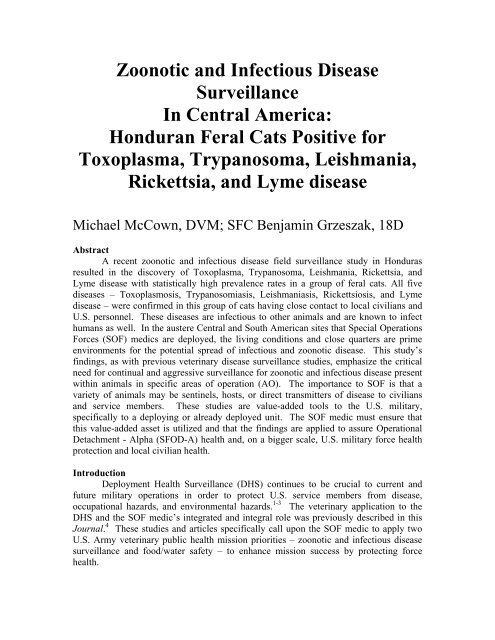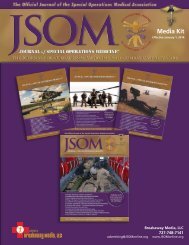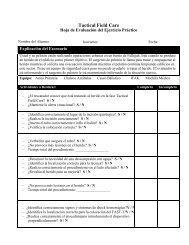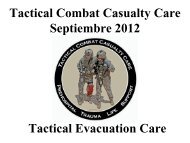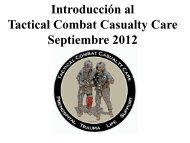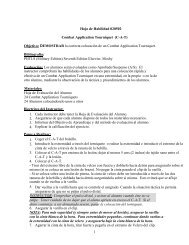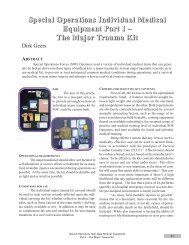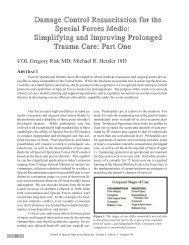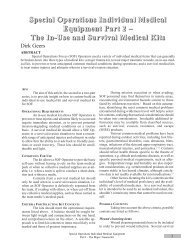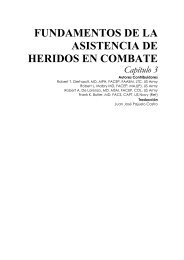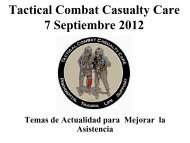McCown M. Grzeszak B. Zoonotic and Infectious Disease ...
McCown M. Grzeszak B. Zoonotic and Infectious Disease ...
McCown M. Grzeszak B. Zoonotic and Infectious Disease ...
Create successful ePaper yourself
Turn your PDF publications into a flip-book with our unique Google optimized e-Paper software.
<strong>Zoonotic</strong> <strong>and</strong> <strong>Infectious</strong> <strong>Disease</strong>SurveillanceIn Central America:Honduran Feral Cats Positive forToxoplasma, Trypanosoma, Leishmania,Rickettsia, <strong>and</strong> Lyme diseaseMichael <strong>McCown</strong>, DVM; SFC Benjamin <strong>Grzeszak</strong>, 18DAbstractA recent zoonotic <strong>and</strong> infectious disease field surveillance study in Hondurasresulted in the discovery of Toxoplasma, Trypanosoma, Leishmania, Rickettsia, <strong>and</strong>Lyme disease with statistically high prevalence rates in a group of feral cats. All fivediseases – Toxoplasmosis, Trypanosomiasis, Leishmaniasis, Rickettsiosis, <strong>and</strong> Lymedisease – were confirmed in this group of cats having close contact to local civilians <strong>and</strong>U.S. personnel. These diseases are infectious to other animals <strong>and</strong> are known to infecthumans as well. In the austere Central <strong>and</strong> South American sites that Special OperationsForces (SOF) medics are deployed, the living conditions <strong>and</strong> close quarters are primeenvironments for the potential spread of infectious <strong>and</strong> zoonotic disease. This study’sfindings, as with previous veterinary disease surveillance studies, emphasize the criticalneed for continual <strong>and</strong> aggressive surveillance for zoonotic <strong>and</strong> infectious disease presentwithin animals in specific areas of operation (AO). The importance to SOF is that avariety of animals may be sentinels, hosts, or direct transmitters of disease to civilians<strong>and</strong> service members. These studies are value-added tools to the U.S. military,specifically to a deploying or already deployed unit. The SOF medic must ensure thatthis value-added asset is utilized <strong>and</strong> that the findings are applied to assure OperationalDetachment - Alpha (SFOD-A) health <strong>and</strong>, on a bigger scale, U.S. military force healthprotection <strong>and</strong> local civilian health.IntroductionDeployment Health Surveillance (DHS) continues to be crucial to current <strong>and</strong>future military operations in order to protect U.S. service members from disease,occupational hazards, <strong>and</strong> environmental hazards. 1-3 The veterinary application to theDHS <strong>and</strong> the SOF medic’s integrated <strong>and</strong> integral role was previously described in thisJournal. 4 These studies <strong>and</strong> articles specifically call upon the SOF medic to apply twoU.S. Army veterinary public health mission priorities – zoonotic <strong>and</strong> infectious diseasesurveillance <strong>and</strong> food/water safety – to enhance mission success by protecting forcehealth.
During recent deployments to Central America, zoonotic <strong>and</strong> infectious diseasefield surveillance studies were performed. A group of animals in contact with a specificsegment of local population <strong>and</strong> U.S. troops was selected <strong>and</strong> blood tested. The goal ofthis study is to enhance mission success in Honduras <strong>and</strong> other Central American AOs byenhancing force health protection. <strong>Disease</strong> surveillance findings increase missionplanners’ health knowledge for specific AOs <strong>and</strong> medical planning for select missions.This will assure force health protection <strong>and</strong> the force’s ability to accomplish the mission.The politically <strong>and</strong> culturally sensitive Humanitarian/Civil Assistance (HCA) SOFmissions will be enhanced by integrating disease surveillance into SOF operationalplanning.This article’s intent is to provide the SOF medic <strong>and</strong> SOF community the findingsof zoonotic <strong>and</strong> infectious disease surveillance study in a Central American AO. PastSOF surveillance studies’ findings of canine Ehrlichiosis 5 <strong>and</strong> Equine <strong>Infectious</strong> Anemia 6in South American military working dogs <strong>and</strong> horses, respectively, should be referenced.All of these findings give a clearer picture of endemic or emerging disease <strong>and</strong> themedical risk of disease to U.S. personnel <strong>and</strong> the local civilian populations.<strong>Disease</strong> Surveillance ResultsThe following disease surveillance study results are from an actual SOF AO inHonduras. The animal study group selected was feral/stray cats in the vicinity that hadcontact with U.S. personnel <strong>and</strong> local civilians. Total cat numbers are thought to bearound 50. Some cats (an estimated 20%) were friendly enough to be held, fed, <strong>and</strong>housed. A representative sample of 12 cats, or 24%, out of the estimated 50 cats weresampled. Cats were safely trapped by trained veterinary personnel. The cats wereexamined for outward signs of disease, <strong>and</strong> ectoparasites were collected foridentification. Blood samples were obtained <strong>and</strong> an IDEXX SNAP® Feline Triple®Test 7 was used on-site to test for Feline Immunodeficiency Virus (FIV), Feline LeukemiaVirus (FeLV), <strong>and</strong> Feline Heartworm (FHW) disease.None of the cats tested positive for FIV, FeLV, or FHW disease. More specificlaboratory testing (IFA screen at 1:32 <strong>and</strong> 1:64) of the remaining blood samplesconfirmed the presence of Toxoplasma gondii, Leishmania donovani, Trypanosomacruzi, Rickettsia rickettsii, <strong>and</strong> Borrelia species (Lyme disease).The prevalence rates of disease in the representative sample group of 12 cats wereas follows:Toxoplasma gondii 33% prevalence rate (4 positive out of 12 cats)Leishmania donovani 25% prevalence rate (3/12)Trypanosoma cruzi 16% prevalence rate (2/12)Rickettsia rickettsii 16% prevalence rate (2/12)Lyme disease 25% prevalence rate (3/12)Ticks were not found at the time the cats were examined, however this study’sresults confirm the presence of ticks in this environment.
DiscussionIn the current austere Central <strong>and</strong> South American areas that SOF medics aredeployed, the living conditions <strong>and</strong> close quarters set a prime environment for the spreadof a variety of diseases, potentially these zoonotic diseases. The initial signs <strong>and</strong>symptoms of some of these zoonotic diseases can be similar to the usual symptoms of asick teammate. These symptoms include headache, general malaise, diarrhea, dermatitis(i.e., rash), nausea, fever <strong>and</strong> vomiting, all of which a SOF medic commonly blame onthe local water supply or food preparation. Given the results of the study, the SOF medicmust see the value of disease surveillance testing in animals. The SOF medic can test thedomestic animals near the detachment’s living quarters with the IDEXX Feline <strong>and</strong>Canine SNAP® Tests <strong>and</strong> the USACHPPM Tick Test Kits at the beginning of thedeployment to get an estimate on possible ectoparasites or zoonotic infectious diseases inthe area. This information will give the SOF medic a h<strong>and</strong> in developing a differentialdiagnoses for future treatments of teammates while deployed, especially in remote areaswhere sending blood off to be cultured or tested is a complicated endeavor.The parasitic protozoon, Toxoplasma gondii, is the causative agent forToxoplasmosis. The SOF medic should be aware that Toxoplasmosis is implicated incausing fetal death in pregnant women <strong>and</strong> serious effects to an immunocompromisedperson.T. gondii tissue cysts are ingested by a cat, the definitive host, when feeding oninfected small animals such as rodents. T. gondii oocysts are then shed in the cat’s feces.Other animals <strong>and</strong> humans may become infected after ingesting these oocysts. 8 This mayoccur when eating improperly washed fruits/vegetables, when eating improperly cookedmeats, or in cases of poor hygiene. Pregnant women should be advised not to clean catlitter boxes due to the potential for fecal-oral transmission. The SOF medic has theopportunity to educate U.S. personnel as well as a local civilian community on improvingpersonal hygiene (proper h<strong>and</strong> washing) <strong>and</strong> prevention of this disease.Trypanosoma cruzi is the parasitic causative agent for Trypanosomiasis diseasesin humans <strong>and</strong> animals. The Reduviidae bug vector deposits feces on the skin of ananimal or human <strong>and</strong> then bites. The host then scratches the superficial bite areaallowing penetration of the infected feces. 9 The SOF medic must be aware that HumanAmerican Trypanosomiasis, also known as Chagas disease, is a very prevalent disease inCentral <strong>and</strong> South American <strong>and</strong> is known to have fatal consequences.The protozoon, Leishmania donovani, is the causative parasite for Leishmaniasis.Spread through the cutaneous bites of s<strong>and</strong> flies, the three types of Leishmaniasis are10Cutaneous, Mucocutaneous, <strong>and</strong> Visceral Leishmaniasis.Rickettsia rickettsii is the bacterium responsible for Rocky Mountain SpottedFever. This bacterium is passed to humans <strong>and</strong> animals through the bites of Dermacentor11species ticks, serving as both reservoirs <strong>and</strong> vectors.Borrelia burgdorferi is the causative bacterium responsible for Lyme disease,12passed through the bite of the Ixodes species tick (deer tick), the primary tick vector.Along with animal blood testing, concurrent ectoparasite surveillance, sampling,<strong>and</strong> identification provide useful information to mission <strong>and</strong> medical planners. The U.S.Army Center for Health Promotion <strong>and</strong> Preventive Medicine (USACHPPM) Tick TestKits are now available [USACHPPM is now the U.S. Army Public Health Comm<strong>and</strong>
(Prov)]. These kits provide sampling containers <strong>and</strong> shipping materials for ectoparasitefield surveillance (see photo). The ectoparasite samples, such as ticks <strong>and</strong> fleas, are sentto USACHPPM to be identified <strong>and</strong> tested for disease organisms they may be carrying.Such diseases caused by ectoparasites include Bartonella (Bartonellosis), Borrelia (Lymedisease), Babesia, Dirofilaria (Heartworm disease), Ehrlichia (Ehrlichiosis), <strong>and</strong>Anaplasma (Anaplasmosis). To order test kits, call 410-436-3616 DSN 584.ConclusionThe findings of this research confirm the presence of infectious <strong>and</strong> zoonoticdisease in a Central American SOF AO. The five diseases all have different vectors ormeans to infect humans <strong>and</strong> animals. Therefore, SOF medics must assure comprehensivepreventive measures for all U.S. personnel operating in these areas, as well as educatinglocal civilian communities.The goal of this article is to increase the SOF medic’s knowledge <strong>and</strong> awarenessof zoonotic <strong>and</strong> infectious disease through surveillance studies in animals. Additionally,the USACHPPM Tick Test Kit ectoparasite field surveillance tool was identified for theSOF medic’s use. The presented findings emphasize the critical need for continual <strong>and</strong>aggressive field surveillance for zoonotic <strong>and</strong> infectious disease present within animals inspecific AOs. These diseases have the capability of significantly impacting missionaccomplishment by affecting force health. Without question, the surveillance studies arevalue-added tools to the U.S. military, specifically to a deploying or already deployedconventional or SOF unit. The SOF medic must ensure that this value-added asset isutilized <strong>and</strong> that the findings are applied to assure ODA health <strong>and</strong>, on a bigger scale,U.S. military force health protection <strong>and</strong> local civilian populations’ health.Note: The authors include the IDEXX test kits as a reference not an endorsement
References1. DoD Instruction 6490.03, Deployment Health, 11 AUG 2006.2. Memor<strong>and</strong>um from the Chairman (MCM) 0028-07, Procedures for Deployment Health, 2 NOV 2007.3. USSOCOM Directive 40-4, Deployment Health <strong>and</strong> Medical Surveillance, 20 MAR 2007.4. <strong>McCown</strong> M, <strong>Grzeszak</strong> B, Rada J. Veterinary Public Health Essentials toDeployment Health Surveillance: Applying <strong>Zoonotic</strong> <strong>Disease</strong> Surveillance <strong>and</strong>Food/Water Safety at SOF Deployment Sites, Journal of Special OperationsMedicine 2009; Vol 9,Ed 4:26-31.5. <strong>McCown</strong> M. <strong>Infectious</strong> <strong>Disease</strong> Discovered in Colombian Military Working Dogs,Journal of Special Operations Medicine 2005; Vol 5,Ed 2:66-70.6. <strong>McCown</strong> M. South American Military Working Horses Positive for Equine <strong>Infectious</strong> Anemia, Journal ofSpecial Operations Medicine 2005; Vol 5,Ed 3:12-16.7. IDEXX Laboratories In-House Tests. www.idexx.com/animalhealth/testkits/tripleOnline References for forward deployed medics:8. en.wikipedia.org/wiki/Toxoplasma_gondii9. en.wikipedia.org/wiki/Trypanosoma_cruzi10. en.wikipedia.org/wiki/Leishmania11. en.wikipedia.org/wiki/Rocky_Mountain_spotted_fever12. en.wikipedia.org/wiki/Lyme_diseaseMiscellaneous Text References:Fowler, Murray. Biology, Medicine, <strong>and</strong> Surgery of South American Wild Animals. Iowa State University Press,2001.Hugh-Jones, Martin. Zoonoses. Iowa State University Press, 1995.Samuel, William. Parasitic <strong>Disease</strong>s of Wild Mammals (Second Edition). Iowa State University Press, 2001.Wall, Richard. Veterinary Ectoparasites: Biology, Pathology <strong>and</strong> Control (Second Edition). Blackwell Science Ltd,2001.BIOGRAPHYDr. <strong>McCown</strong> is an UF CVM graduate <strong>and</strong> had the distinct honor <strong>and</strong> privilege to work with SOF medics<strong>and</strong> other SOF NCOs while serving on active duty with SF thru 2005. He served one combat tour inAfghanistan in support of the Global War on Terrorism, three deployments to South America, <strong>and</strong> a seriesof other missions to Central <strong>and</strong> South America.SFC Benjamin <strong>Grzeszak</strong> is a Special Forces Medical Sergeant currently assigned to 7th SFG(A). He hasserved three combat tours with 7th SFG(A) in Afghanistan in support of the Global War on Terrorism <strong>and</strong>two deployments to South America.


